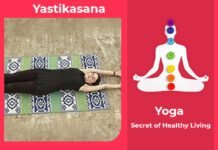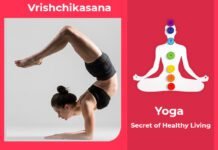What is Adho Mukha Vrikshasana
Adho Mukha Vrikshasana Vrikshasana is a tree pose which means you are standing with your hand raised towards the sky.
- Adho-Mukha-Vrikshasana can be termed as a tilted tree pose where in your hands are supporting the entire body weight. This asana when done by beginners has to be done very carefully as balancing yourself on your hand cannot be that easy.
- While doing this asana, fear of falling is natural. So the basic pose will be described with the heels supported against a wall.
Also Know as: Downward Tree Posture, Vriksha Asana, Vriksh Asana, Vriks Pose, Vrksasana
How to start this Asana
- Perform Adho-Mukha-Svanasana (Downward-Facing Dog Pose) with your fingertips an inch or two away from a wall, hands shoulder-width.
- Now bend left knee and step the foot in, closer to the wall, but keep the right leg active by extending through the heel.
- Then take a few practice hops before you try to launch yourself upside down.
- Lift your right leg toward the wall, and immediately give push to your left heel to lift it from the floor and also straighten the left knee.
- As both legs lift from the ground, use your inner abdominal muscles to lift your buttock over your shoulder.
- Hop up and down like this several times, each time pushing off the floor a little higher.
- Exhale deeply each time you hop.
- Eventually you’ll be able to kick all the way into the pose.
- At first your heels may crash into the wall, but again with more practice you’ll be able to swing your heels up lightly to the wall.
- If your armpits and groins are tight, your lower back may be deeply arched.
- To lengthen this area, draw your front ribs into your torso, reach your tailbone toward your heels, and slide your heels higher up the wall.
- Now squeeze the outer legs together and roll the thighs in.
- Hang your head from a spot between your shoulder blades and gaze out into the center.
- Stay in the position for some time and then relax.
- Be sure to alternate your kicking leg, one day right, next day left.
How to end this Asana
- To release, stay in the pose for 10 to 15 seconds, breathing deeply.
- Gradually work your way up to 1 minute.
- Release with an exhalation, bring the back slowly down onto the floor.
- Keep your shoulder blades lifted and broad, and take one foot down at a time, each time with an exhalation.
- Stand straight for 30 seconds to 1 minute for relaxiation.
Video Tutorial
Benefits of Adho Mukha Vrikshasana
According to research, this Asana is helpful as per below(YR/1)
- Strengthen the shoulders, arms, and wrists.
- Stretches belly muscles.
- It improves the sense of balance.
- Calms the brain and helps relieve stress and mild depression.
Precaution to be taken before doing Adho Mukha Vrikshasana
As per several scientific studies, precautions need to be taken in diseases mentioned as per below(YR/2)
- Not for the persons who have back, shoulder, neck injury.
- Don’t do this asana when you are suffering from headache, heart condition, high blood pressure, menstruation.
- If you are experienced with this pose, you can continue to practice it late into pregnancy.Avoid this asana if you are pregnant.
So, consult your doctor if you have any of the problem mentioned above.
Histroy and scientific base of Yoga
Due to the oral transmission of sacred writings and the secrecy of its teachings, yoga’s past is riddled with mystery and confusion. Early yoga literature were recorded on delicate palm leaves. So it was easily damaged, destroyed, or lost. Yoga’s origins may be dated back over 5,000 years. However other academics believe it could be as old as 10,000 years. Yoga’s lengthy and illustrious history may be split into four distinct periods of growth, practise, and invention.
- Pre Classical Yoga
- Classical Yoga
- Post Classical Yoga
- Modern Yoga
Yoga is a psychological science with philosophical overtones. Patanjali begins his Yoga method by instructing that the mind must be regulated – Yogahs-chitta-vritti-nirodhah. Patanjali does not delve into the intellectual underpinnings of the need to regulate one’s mind, which are found in Samkhya and Vedanta. Yoga, he continues, is the regulation of the mind, the constraint of the thought-stuff. Yoga is a science based on personal experience. The most essential advantage of yoga is that it helps us to maintain a healthy bodily and mental state.
Yoga can help to slow down the ageing process. Since aging starts mostly by autointoxication or self-poisoning. So, we can considerably limit the catabolic process of cell degeneration by keeping the body clean, flexible, and properly lubricated. Yogasanas, pranayama, and meditation must all be combined to reap the full advantages of yoga.
SUMMARY
Adho Mukha Vrikshasana is helpful in increase flexibility of muscles, improves shape of the body, reduce mental stress, as well improves overall health.




